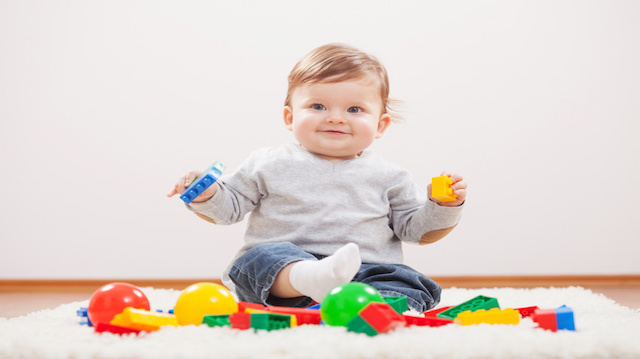
There are so many cute products available for babies and toddlers, it can be hard to choose. Any number of appealing colors, textures and patterns can catch your eye, each with different features and benefits. But how many of these products are actually toxic?
Rapidly growing little ones are vulnerable to environmental toxins, even before they’re born, so it’s important to stay informed and prevent exposure to damaging chemicals. Indirect exposure is harmful too, as pollutants have been found in breastmilk.
For decades, plastic has been the leading material for kids’ stuff — it’s so lightweight, durable and colorful! Recently, however, the common plastic ingredient bisphenol A (BPA) was discovered to be damaging to reproductive and hormonal development, as well as potentially carcinogenic. This substance was subsequently banned from children’s products sold in the United States as of 2013.
We may feel like we’ve escaped the worst, but in fact research shows that BPA-free plastic products are just as toxic, if not more so. Bisphenol A is simply replaced with other similar chemicals (such as bisphenol F), which are still shown to leach toxins into food, water, and bodily fluids or tissues.
In search of a safe alternative, some parents have turned to natural rubber for baby products like bottles, soothers, teethers and toys. But is natural rubber truly innocuous? We did some digging to uncover the truth.
What is natural rubber?
Prior to World War II, natural rubber was the primary material for products requiring flexibility and durability.
The industrial age following WWII brought about synthetic substances such as silicone and many different varieties of plastic. Although plastic very quickly became a mainstay, the recently discovered toxicity of many of these materials is prompting a return to the use of natural rubber.
This old-school material is made from sap or milk, which is harvested from the rubber tree, also called a Hevea tree. It can be sustainably collected if the tapping is done correctly. Most natural rubber is harvested in Asia.
Benefits of natural rubber for baby products
Natural rubber has many characteristics which plastics have been carefully engineered to emulate. It is naturally soft and flexible, and remains durable with extended use (like the voracious chewing of a teething four-month-old!).
Natural rubber wins over plastics with many positive attributes. It is entirely nontoxic and free of petroleum or heavy metals. The material is a renewable resource and is biodegradable.
 Furthermore, natural rubber does not leach any worrisome byproducts, which has been a major issue with plastics. Silicone is commonly believed to be similarly inert and hypoallergenic, but some recent studies have indicated that heating or cooling can cause it to leach. This is a concern when baby products are often boiled to be cleaned, or are frozen to provide teething relief. Silicone is also a nonrenewable, petroleum-based material.
Furthermore, natural rubber does not leach any worrisome byproducts, which has been a major issue with plastics. Silicone is commonly believed to be similarly inert and hypoallergenic, but some recent studies have indicated that heating or cooling can cause it to leach. This is a concern when baby products are often boiled to be cleaned, or are frozen to provide teething relief. Silicone is also a nonrenewable, petroleum-based material.
What about latex allergies?
It’s true that latex is also made from natural rubber, and the rubber may trigger an allergic reaction in a small percentage of the population. However, some companies are producing natural rubber products that are purified of any of the allergenic proteins (called nitrosamines) and are tested to be hypoallergenic.
How to care for natural rubber products
Since natural rubber is minimally processed, it can become softened if exposed to heat, such as direct sunlight or boiling. Instead, cleaning with water and a gentle soap or vinegar will keep it clean. Natural rubber will change color with use, which is normal and expected.
Natural rubber is not static-causing, so it does not attract dust like many other pacifiers or bottle teats will.
On the whole, scientific research and anecdotal evidence from conscious parents seems to indicate that natural rubber products (especially those processed to exclude the latex-like nitrosamine proteins) are an exceptionally safe and environmentally-conscious option for babies and toddlers.
On the lookout for other holistic options for baby care? Some people find that amber is beneficial for babies, providing soothing and anti-inflammatory properties. We also recommend trying these homemade natural baby products to replace commercially produced ones, which may contain toxic ingredients.
—Liivi Hess
Liivi is an Integrative Nutrition Health Coach and is training to become a doula. She inspires women to find peace and personal power by taking control of health and fertility naturally. Liivi‘s passion is ancestral nutrition and primal lifestyle design. She and her partner Will live between Toronto, Canada and Queenstown, New Zealand.
Sources:
http://www.ncbi.nlm.nih.gov/pubmed/10803889
http://www.sciencedirect.com/science/book/9780857096838
http://www.cdc.gov/niosh/docs/97-135/
http://everydaylife.globalpost.com/safe-rubber-babies-chew-1705.html
http://www.ecobabysteps.com/2009/11/09/toy-monday-why-natural-rubber/
Zhang, Kai, et al. “Determination of siloxanes in silicone products and potential migration to milk, formula and liquid simulants.” Food Additives & Contaminants: Part A 29.8 (2012): 1311-1321.

